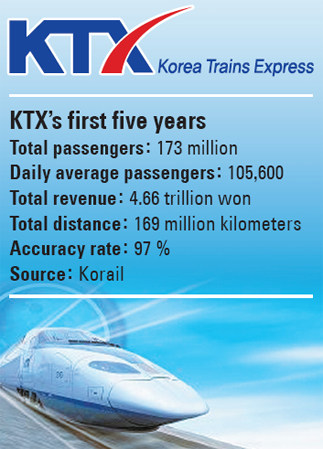KTX passengers rise 47% over a five-year duration

Over the past half-decade, the bullet train that runs at 300 kilometers (186 miles) per hour has become a main transportation artery, halving travel time between the country’s two biggest cities, Seoul and Busan.
Since its launch in 2004, more than 170 million passengers have taken the train and 105,000 ride KTX each day on average.
“The average number of daily travelers has picked up 47 percent in the past five years,” said the Korea Railroad Corporation, the KTX operator, in a statement.
The total number of KTX passengers is set to exceed 200 million in December, according to Korail.
So far the bullet train has earned 4.66 trillion won ($3.35 billion) in revenue and the total distance covered is 168.9 million kilometers, which is equivalent to 2,517 trips around the Earth.
The accuracy ratio - the percentage of trains that arrive within five minutes of the scheduled time - has reached 97 percent, against 87 percent at the start of operations.
The train has two key routes. The Gyeongbu line that links Seoul and Busan passes Gwangmyeong, Cheonan, Daejeon and East Daegu. The journey used to take four hours and 10 minutes by Saemaeul, but the KTX has shortened the journey by one and a half hours.
The Honam line, which connects Seoul and Mokpo, South Jeolla, goes via Nonsan, Iksan, Gimje and Gwangju.
The faster journey times have changed the way people organize their work week accommodations. Many workers who used to find lodgings near their workplace to avoid a lengthy commute to the capital now can live further afield. While it takes approximately two hours to travel between Seoul and Daejeon by bus, by KTX the trip is no longer than 50 minutes
Kim Ji-hoon, a company worker in Daejeon, says without KTX he wouldn’t have imagined going to graduate school in Seoul. He takes the KTX every weekend to attend the Korea Development Institute graduate school in northern Seoul, and door-to-door the trip takes less than two hours each way.
“The 50-minute train ride is no longer than the time it takes to travel within Seoul by subway,” he said.
Thanks to the double benefits of shorter travel time and relatively cheaper costs, KTX has emerged as the most popular form of transportation in recent years.
According to Korail, KTX passengers accounted for 63 percent of all travelers on the Seoul-Busan route, with planes at 17 percent, private cars at 8.1 percent and express bus at 7.3 percent.
Ordinary trains - the Mugunghwa and Saemaeul - only accounted for 3.3 percent and 1.3 percent, respectively. Passengers on flights between the two cities totaled 5.3 million in 2003, while the figure was more than halved to 2.4 million last year.
KTX destinations have undergone major economic development, too. According to a recent study by Huh Jae-wan, a professor of city and region planning at Chung-Ang University, the number of jobs in Busan increased by 0.33 percentage point from 2004 to 2007, compared with minus 0.34 percentage point growth between 2000 and 2003.
In the three-year time span until 2007, Cheonan in South Chungcheong and Seoul saw their respective job growth rates increase by 0.21 percentage point and 0.06 percentage point.
“KTX is a driving force behind regional economic progress,” Huh said in the report.
Korail plans to launch another KTX service late this year. Tentatively named the KTX-II, the bullet train is based on homegrown technologies, whereas its predecessor was built on France-based TGV technologies.
The development was made through a cooperative project among academia, the government and industry that began in 1996 and cost 225.8 billion won.
With the KTX-II, Korea will be the fourth country in the world to use its own technology to build a high-speed train with a maximum speed of 330 kilometers per hour. The other nations are France, Germany and Japan.
The streamlined design of the KTX-11 has minimized air resistance, and the use of aluminum alloy has reduced the weight, according to the Ministry of Land, Transport and Maritime Affairs.
The train reaches 300 kilometers per hour in five minutes and 16 seconds from the point of departure, around one minute faster than the previous version of the train.
All seats can be rotated 360 degrees on the KTX-II, thus relieving customers of the inconvenience of facing the train’s rear.
Korail said the second high-speed train in Korea will have a six-month trial period before it goes into use. Initially, it will be deployed on the lines to North and South Jeolla, and it will then be deployed on other routes in the near future.
By Seo Ji-eun [spring@joongang.co.kr]










with the Korea JoongAng Daily
To write comments, please log in to one of the accounts.
Standards Board Policy (0/250자)